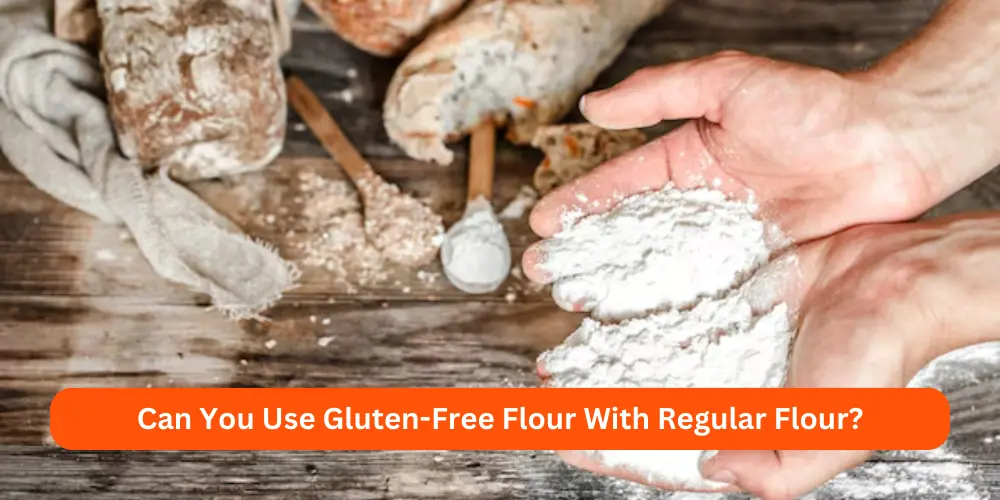

In the world of baking and cooking, the topic of mixing gluten-free and regular flour can often spark curiosity and uncertainty. The popularity of gluten-free diets is increasing, and people want diverse culinary experiences. It’s important to understand the possibilities and best practices for combining these two types of flour. In this comprehensive guide, we will delve into the intricacies of Can I mix gluten-free and regular flour? We’ll explore the reasons behind it, provide tips for success, and address common misconceptions.
Can I Mix Gluten-Free And Regular Flour?
To begin our exploration, it’s important to grasp the basic concepts of gluten-free flour and regular flour. Explore “Can I mix gluten-free and regular flour?” Gluten-free flour is made from alternative grains or starches, such as rice flour, almond flour, or tapioca flour.
Yes, you can mix gluten-free and regular flour, but it may alter the texture and flavor of your recipe. Experiment cautiously to achieve the desired results.
It is free from gluten proteins. Regular flour, but, contains gluten proteins. These proteins give baked goods their structure and elasticity.
Reasons For Mixing Gluten-Free And Regular Flour
Mixing gluten-free and regular flour can offer a myriad of benefits. By combining the two, you can achieve improved texture and flavor in your baked goods. Mixing gluten-free and regular flour is versatile and broadens culinary possibilities.
Ratios And Measurements
When it comes to mixing gluten-free and regular flour, finding the right ratios and accurate measurements is crucial. The proportions may vary depending on the recipe and desired outcome. Experimenting and observing the texture and consistency of the dough or batter will help you find the best ratio for your specific needs.
Culinary Applications
Blending gluten-free and regular flour has various culinary uses. It works well in bread, pizza dough, cookies, and cakes, creating delightful creations. Note that some recipes may need adjustments to accommodate the unique characteristics of each type of flour.
Tips For Successful Mixing
To ensure successful results when mixing gluten-free and regular flour, here are some valuable tips to keep in mind:
- Thoroughly blend the flours before incorporating them into your recipe.
- Consider adding xanthan gum or other binding agents to improve the texture and structure of gluten-free baked goods.
- Pay close attention to the hydration levels and adjust as needed to achieve the desired consistency.
- Try different blends and ratios to discover your preferred combination for specific recipes.
Substituting Gluten-Free Or Regular Flour
If one type of flour is unavailable, you can substitute it with another. But, it’s important to know that the substitution may affect the final texture and taste of the dish. Consider the characteristics of each flour type and make adjustments to achieve the desired result.
Common Mistakes To Avoid
Mixing gluten-free and regular flour can open up many culinary possibilities. But, it’s crucial to be aware of common mistakes that can result in disappointing outcomes. Avoid pitfalls by using correct measurements. Don’t overmix the batter, and remember to adjust cooking times and temperatures.
Related Guides:
Can You Use Gluten-Free Flour With Regular Flour?

It is possible to use gluten-free flour with regular flour. Blend these two types of flour to enjoy the benefits of both while accommodating dietary restrictions or preferences. However, it’s necessary to find a good middle ground. This ensures a harmonious blend and avoids overpowering the flavors.
Can I Mix Gluten Flour With All-Purpose Flour?
While it is possible to mix gluten flour with all-purpose flour, it is important to consider the specific requirements of your recipe. Gluten flour, also known as vital wheat gluten, is a concentrated form of gluten. It is added to recipes that must have extra structure and elasticity. Adding gluten flour to all-purpose flour can enhance the gluten content, resulting in a chewier texture.
Does Gluten-Free Flour Take Longer To Cook Than Regular Flour?
In general, gluten-free flour may need longer cooking times compared to regular flour. The absence of gluten proteins affects the texture and baking process. It’s crucial to track your baked goods and adjust cooking times as needed. This ensures they are cooked and have the desired consistency.
How Does Gluten-Free Flour Affect Baking?
Gluten-free flour can influence various aspects of the baking process. Without the presence of gluten, the texture and structure of the final product may differ from traditional baked goods. Gluten-free flours often result in denser and crumblier textures. Understand these differences and make appropriate adjustments. This will help you get the very best result you can.
Final Thoughts:
Mixing gluten-free and regular flour opens up a world of culinary creativity. It allows individuals with dietary restrictions to enjoy a wider range of baked goods. In this topic, discover can I mix gluten-free and regular flour. Understand the fundamentals. Experiment with different ratios. Adapt your techniques. This way, you can incorporate both types of flour into your recipes. Remember, the journey of mixing flour is an opportunity for exploration and personalization in the kitchen. Embrace the possibilities, unleash your creativity, and savor the delicious results that await you.
Sources:
- By Beth Goldowitz, Can I substitute gluten free all-purpose flour in for regular all-purpose flour in a layer cake? Posted 6 years ago.
- By Beth Goldowitz, Can you substitute gluten-free flour for all purpose flour in recipes? Posted 3 Years Ago.



